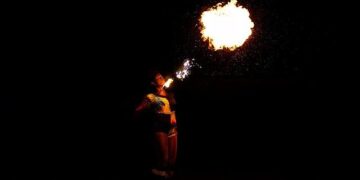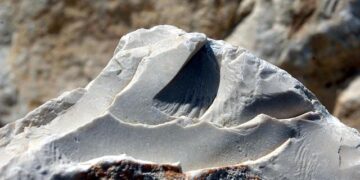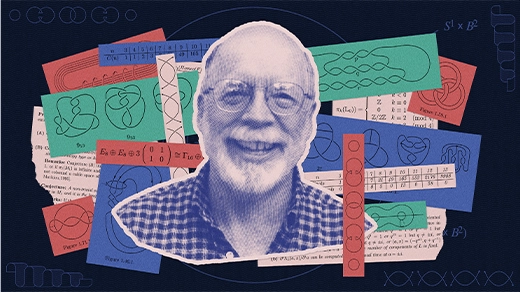This past October, dozens of mathematicians gathered in Pasadena to create the third version of “Kirby’s list” — a compendium of the most important unsolved problems in topology, the study of deformable shapes.

Kristina Armitage/Quanta Magazine; source: George M. Bergman/MFO
Introduction
On a recent October morning, Rob Kirby stood in front of a roomful of mathematicians and told them not to feel bound by the way he’d done things in the past.
For the past half-century Kirby, 85, has been a central figure in low-dimensional topology, the study of deformable shapes. In addition to important research contributions, in 1978 he published the first version of what came to be known as “Kirby’s list” — a collection of 80 open problems that helped set the research agenda for the field over the next few decades. Two decades later, in 1997, he published a second, equally influential version of the list.
The few dozen mathematicians Kirby was addressing had convened at the American Institute of Mathematics (AIM) in Pasadena to create a third version of the list. Not that all the problems on the prior lists had been solved — most hadn’t — but many had gone out of style. While math is eternal, the field is practiced by humans who follow fads, and many of the old questions weren’t considered as interesting anymore.
“We think some subfields are prestigious and others are like, nobody cares about it.” said Maggie Miller of the University of Texas, Austin, one of 14 editors of the list.
The conference was conceived by Daniel Ruberman of Brandeis University, who had been Kirby’s student in the early 1980s, and Inanç Baykur of the University of Massachusetts, who was a postdoctoral fellow under Ruberman. They wanted the list to be made up of hard and important problems.
“It should be a problem that is sufficiently interesting that if a solution came out, it would have the potential to change the field,” Miller said. Baykur added: “Maybe a small percentage can be solved in the next two to three years.”

Inanç Baykur of the University of Massachusetts and Daniel Ruberman of Brandeis University organized a conference intended to create a new list of important problems in low-dimensional topology.
Courtesy of Inanç Baykur; Ann Borst
Introduction
The ways mathematicians decide what is important have themselves changed in the half-century since Kirby published his first list. Even if the truth or falsity of individual conjectures is a matter of objective truth, ranking their importance is a subjective, social process. And that process looks very different in today’s globally interconnected world than it did in the 1970s. The story of the new list is the story of those changes.
The Beginning of the List
Kirby’s own career started with a problem list. In 1963, as a graduate student at the University of Chicago, he attended a conference in Seattle where the mathematician John Milnor presented a list of the seven most important open problems in topology. The last problem was the annulus conjecture, which states that the spaces between two appropriately defined spheres always takes the shape of an annulus, which is the region between two concentric circles.
This is true for circles and normal, three-dimensional balls, but in higher dimensions — involving pairs of spheres of five or six or any number of dimensions — surprising things happen. In 1969, while an assistant professor at the University of California, Los Angeles, Kirby proved it’s true for dimensions five and higher given some restrictions (the spheres have to be smooth in a particular mathematical sense).
Based on that result, UCLA promoted him directly to full professor and doubled his salary. Two years later, he won the prestigious Oswald Veblen Prize in Geometry. Kirby attributes this early-career success in part to the existence of the Milnor list, which provided him with a greater variety of projects to choose from than he would have received from the people immediately around him in graduate school.
“For those who like to work on problems and don’t necessarily want to do what their adviser tells them to do, a problem list is valuable,” he said.
Kirby began assembling his first problem list in August 1976 at an American Mathematical Society conference at Stanford University. He built the list over the next two years, through phone calls, letters, and informal conversations with mathematicians at conferences he attended, and he published it as an extended journal article in 1978.

Fashions in math come and go. “We think some subfields are prestigious and others are like, nobody cares about it.” said Maggie Miller of the University of Texas, Austin, one of 14 editors of the new list.
Do Pham for Stanford University
Introduction
As Miller puts it, “He just called everybody he knew on the phone.”
The list contained about 80 problems organized into five chapters. The first four chapters were on one-dimensional knots, two-dimensional surfaces, and three- and four- dimensional manifolds (spaces like the surface of a sphere that appear flat locally but can have more complicated global structure). The fifth chapter was for miscellaneous problems. Though Kirby consulted widely to pull the list together, the final product was unmistakably his.
“I was more inclusive than exclusive,” Kirby said, but added, “I was pretty much the final arbiter.”
The Second List
The late 1970s were an auspicious time to create a problem list in topology. The field was small at the start of the decade, and over the next 10 years it exploded. In 1981 Michael Freedman solved a four-dimensional version of the Poincaré conjecture in a monumental proof that would take years to digest. (The conjecture asks if mathematical objects that resemble spheres must in fact be spheres. The answer, Freedman proved, is yes.) A year later William Thurston published the geometrization conjecture, which classifies some topological structures into geometric categories. The conjecture brought tools from analysis (an advanced form of calculus) squarely into topology. That same year Simon Donaldson introduced differential geometry (which combines calculus and geometry) into the field with his work on four-dimensional manifolds.
“It’s hard to describe how fast the progress was. It was one of those great periods in mathematics, with one revolution after another,” Ruberman said.
As a result of all this activity, Kirby’s list was nearly outdated within a few years. But building problem lists wasn’t Kirby’s main occupation. It wasn’t until a conference at the University of Georgia in the summer of 1993 that he decided to overhaul the list.
Kirby began collecting problems at the conference and continued the work over email, which was not in common use when he’d put together the first list. As a result, the list sprawled. The final list contained 415 problems and was published as a book in 1997. Once the third list got underway, the second effort retroactively came to be known as K2, as in the second version of Kirby’s list, and also as a nod to the second-highest mountain in the world. The expanded format helped cement the second version of the list as a touchstone and a scorecard. Solving a Kirby problem gets young mathematicians noticed.
“If you’re writing a letter of recommendation for someone and they’ve solved a Kirby problem, you mention that in your letter,” said John Baldwin, a mathematician at Boston College who participated in the workshop and is helping to edit the list.
Arunima Ray, a group leader at the Max Planck Institute for Mathematics in Bonn, Germany who attended the workshop, said one of the first things her doctoral adviser did after she passed her qualifying exams in 2011 was to give her a copy of the K2 list, “to get a sense of the big problems that people are interested in.”
Of course, decisions about what is important are inflected by who is in the room making those decisions. The Kirby lists reflect a pedagogical philosophy that grew out of Kirby’s sociopolitical worldview. He describes himself as a classical liberal and cites the 19th-century British philosopher John Stuart Mill as an important influence on his thinking.
“Classical liberals really did believe in liberty, free speech, and a light hand from the government, so that’s sort of my viewpoint,” he said. “In a little way that goes along with not telling my students what to do. It’s a little bit giving them free rein.”
Kirby infuses these beliefs into the way he thinks and talks about the math community. In 2021, along with over 1,000 other California-based mathematical and scientific professionals, he co-signed an open letter criticizing the state’s proposal to adopt a new K-12 math curriculum that would have made social justice considerations more central to the way the state teaches the subject. The California proposal has come under considerable criticism in the mathematics community for, among other things, limiting the availability of advanced courses, and for de-emphasizing pre-calculus courses in favor of “data science.”

In the 1970s, Rob Kirby created a list of central questions in topology that helped set the field’s agenda for decades afterwards.
George M. Bergman/MFO
Introduction
Kirby has historically been a skeptic of the existence of structural biases in mathematics, including regarding the field’s gender imbalance. In the 1970s, about 10% of mathematicians were women; today almost 30% are, according to a 2020 report by the International Science Council.
In an article that he wrote in the 1990s, and which was submitted for publication in the Notices of the American Mathematical Society but never published, Kirby made the case that these dismal numbers were not the result of any bias in the field. “In my view, the smaller number of women in math is not due to discrimination by men nor to any inherent inferiority in women, but rather is due to the simple fact that more men than women choose to enter mathematics,” Kirby wrote.
To many mathematicians, the reality that few women enter the field is anything but a simple fact. “Evidence suggests that there is a feedback effect here: because there are so few female professors, female students can’t see a clear career path through mathematics, so they decide not to pursue a Ph.D.,” wrote four prominent female mathematicians in 2022 in the Times Higher Education Supplement. As the International Science Council report put it, after analyzing a dataset of hundreds of thousands of published mathematical papers, “various structural and systemic factors must have affected the careers of female mathematicians in ways different from those of men.”
Kirby’s views are well known within the low-dimensional-topology community. I asked Kirby if he thought that made it harder for women to participate in settings like the recent conference where he had a prominent role. He said he didn’t know because, with the exception of one mathematician, no one had ever brought it up with him.
Ray, who serves as the gender equality officer at the Max Planck Institute, said “I don’t think it shaped the way the conference felt. I do think it shapes how he is viewed in the field of mathematics, but I think in general we do separate the mathematics from the mathematician.”
A Communal Effort
Just as it had after K1, low-dimensional topology advanced quickly following the release of K2. One major development was the elaboration of Seiberg-Witten theory, which used ideas from physics to distinguish between four-dimensional manifolds. By the late 2000s, the Kirby list was ready for updating again.
“The thing is, the field became much bigger since the 1990s, it became huge,” Baykur said.
This time the impetus for creating a new list came from Ruberman and Baykur. They began collecting problems around 2013. But between their other obligations and the pandemic, it wasn’t until October 2023 that they managed to gather a group of topologists to meet in person. They wanted the third version of the list to be more of a communal effort.
“The initial list was wonderful, I’m so glad it was there, but this new format is commendable in making that a bit more open,” Ray said.
In late 2022, Kirby joined Baykur and Ruberman as a co-organizer of the conference. They invited experts from the major areas of low-dimensional topology — corresponding to the same five-chapter structure Kirby had used in earlier versions of the list — but tried to avoid inviting so many specialists that no one had anything in common with anyone else.
Baykur and Ruberman did most of the organizing while Kirby took on more of a titular role.
“It’s kind of like Rob’s baby, you know, like he’s emotionally in charge. But Danny and Inanç handled all the logistics,” Miller said.
On Monday, October 30, the group began work on the K3 list (as it was called for obvious reasons and also in reference to K3 surfaces, which are important objects in topology).
The list reflected ways in which low-dimensional topology had grown since K2. In the early 1990s the work of Andreas Floer gave rise to new methods for sorting three-dimensional manifolds. By the end of that decade those methods had blossomed into an entire area of study, Heegaard Floer homology, and within that area there are now a number of different approaches to distinguishing manifolds. Those approaches should all be consistent with each other, but it’s not known for sure that they are, and K3 will include questions that aim to settle the matter.

“If you’re writing a letter of recommendation for someone and they’ve solved a Kirby problem, you mention that in your letter,” said John Baldwin, a mathematician at Boston College who is helping to edit the new list.
Brittany Baldwin
Introduction
Kirby set up camp in the main lecture hall where the mathematicians gathered each morning, mostly avoiding the brainstorming sessions. On Tuesday morning Dave Gabai of Princeton University gave a lecture to the whole group on connections between the Schoenflies conjecture and the Poincaré conjecture, arguably the two most important open problems in smooth four-dimensional topology.
The Schoenflies conjecture has a similar flavor to the annulus conjecture Kirby worked on in the 1960s. It predicts that if two spheres differ by one dimension (like a circle versus the surface of a ball), and you embed the lower-dimensional one (the circle) into the higher-dimensional one (the surface of a ball), the former always cuts the latter into the equivalent of two balls. This is clearly true when you etch a circle onto a globe (as if to form the equator), but as with the annulus conjecture, it’s less clearly true in higher dimensions.
Kirby found Gabai afterward, and the two talked for hours about the implications of Gabai’s talk. At other points during the week Kirby spent time emailing his extensive network in the math community for contributions to the list.
“In some ways it was rather similar to what he’d done in the previous lists,” Ruberman said. “He didn’t tend to come into the rooms as much. [He’d] be emailing people, saying, ‘Someone at the workshop said this, what do you think of that?’”
The War Room
On the last two days of the conference Baykur and Ruberman asked attendees to write up the problems they’d compiled. It felt like a war room, as the mathematicians rushed to write summaries of the problems they’d settled on before their flights home.
“It really felt like when you’re in college, and you have homework due the next day, and everybody in the class is in a room, and it’s 2 a.m.,” Miller said.
A shared document in which the mathematicians were compiling the list was nearly empty on Thursday morning, but grew quickly with dozens of mathematicians editing at once. By Friday, the list of problems was more than 250 pages long. The whirlwind experience was almost unrecognizable compared to Kirby’s two previous efforts.
“It made me feel old in the sense that back when I did K2, I did that over a period of two to three years. I would sit down with a person and we’d sort of write the problem together,” Kirby said. “With K3, I was only involved in a modest number of problems.”
Baykur and Ruberman hope to publish a list of some 400 problems by the end of the year, after revisions and additions from topologists who weren’t at the Pasadena meeting. Baykur, Ruberman and the other editors are still debating how frequently to update the list. They could extend the shelf life of K3 by keeping an online version current, but they see drawbacks in doing so. The first two lists, Baykur said, “were historical documents and it was extremely informative to see how they were looking at things in the 1970s and 1990s, and how they thought about mathematics. I wanted to have a similar contemporary document.”
Next article
A Multitalented Scientist Seeks the Origins of Multicellularity
>>> Read full article>>>
Copyright for syndicated content belongs to the linked Source : Quanta Magazine – https://www.quantamagazine.org/a-new-agenda-for-low-dimensional-topology-20240222/




















![Forest ecology cannot be reduced to arithmetic, says M.I. Varghese [Interview] – Mongabay-India](https://earth-news.info/wp-content/uploads/2025/12/328946-forest-ecology-cannot-be-reduced-to-arithmetic-says-mi-varghese-interview-mongabay-india-350x250.jpg)










![Forest ecology cannot be reduced to arithmetic, says M.I. Varghese [Interview] – Mongabay-India](https://earth-news.info/wp-content/uploads/2025/12/328946-forest-ecology-cannot-be-reduced-to-arithmetic-says-mi-varghese-interview-mongabay-india-120x86.jpg)